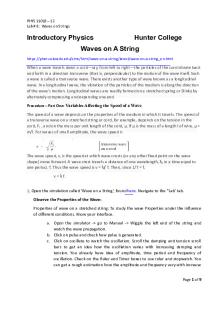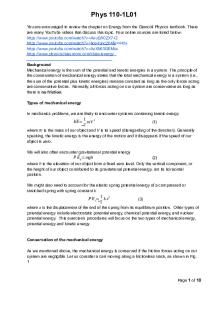PHYS Hooke\'S LAW LAB - LAB REPORT -----HOOKE\'S LAW PDF

| Title | PHYS Hooke\'S LAW LAB - LAB REPORT -----HOOKE\'S LAW |
|---|---|
| Course | General Physics I: Algebra Based |
| Institution | New York City College of Technology |
| Pages | 12 |
| File Size | 693.3 KB |
| File Type | |
| Total Downloads | 17 |
| Total Views | 129 |
Summary
LAB REPORT -----HOOKE'S LAW ...
Description
PHYS 1443 D715 LAB REPORT NEW YORK CITY COLLEGE OF TECHNOLOGY |PHYSICS ALGEBRA BASED| PHYS 1443
Done by Touheda Khanom Prof. Lusik Hovhannisyan
1
LAB#10: HOOKE’S LAW AND SPRING CONSTANT
DATE OF THE EXPERIMENT - 04/6/2020 DUE DATE OF THE EXPERIMENT - 4/22/2020
2
TABLE OF CONTENTS
Objective..……………………………………………………………….page 3 Theoretical background…………………………………………………..page 3-4 Procedure………………………………………………………………page 4-5 Data……………………………………………………………………...page 5 Graphs…………………………………………………………………page 6-7 Sample Calculation……………………………………………page 8-10 Conclusion………………….…………………………………………page 10 Question…………………………………………………………page 10-11
3
OBJECTIVES The purpose of the laboratory was to study Hooke’s law and to evaluate the spring constant using two methods, the static and dynamic methods of measurements. We learned Hooke’s law. We used both the static method and the dynamic method of measurement of spring constant. Moreover, we also interpreted data from a graph of mass versus square of period and force versus elongation x of spring to find the springs constant.
THEORETICAL BACKGROUND Spring force is proportional to the displacement x of the end of the spring from its position when the spring is relaxed. F = - kx In the expression above, x indicates the amount by which the spring is stretched or compressed from its unstrained length, an k i s a positive constant which is known as the spring constant. The SI units of k a re Newton per meter. Hooke’s law is a mathematically exact estimate of a particular force. The linear relationship between the force and the displacement is no longer met if spring is stretched too far.
k=
ΔW Δx
The spring constant k d epends on the material for a helical spring. We can evaluate k b y hanging different weights at the end of vertical spring. The magnitude of the spring force is equal to the magnitude of the hanging mass because the spring force and the hanging weight balance each other. Therefore, F = W = kx The magnitude of the hanging weight is proportional to the elongation x of the spring. We can experimentally determine the spring constant for any spring. This method of determining the spring constant is known as the static method.
T = 2 π
√
T = 2π
m + m3s k
√
m k
4
The equation above provides the period of simple harmonic motion in terms of the spring constant k a nd moving mass m attached with the spring. The period is independent of the amplitude and the period of motion remains constant throughout the motion. The slope of the straight line is equal to
k 4π 2
4 π2 × Slope we . Therefore, using this equation k =
can experimentally determine the spring constant for any spring. This method of determining the spring constant is known as the dynamic method. PROCEDURE 1. In this laboratory, we evaluated the spring constant k by using two methods; the static method and the dynamic method. 2. We first measured the hanging weights and the elongation x of the springs then found k from the slope of the graphs of the magnitude of the applied weight W versus the elongation x. 3. We then measured the period of oscillation T of the vertical spring and hanging mass then found k from the slope of the graph of the total hanging mass versus the square of the period of oscillation T 2 . 4. To find the data for the static method, we adjusted the position of the red pointer on the spring staff to reading on the meterstick and then we adjusted the marker on the meterstick with the red pointer and read the position of the pointer. After that, we recorded the value as the original position L0 on the data table 10.1. 5. To find the position L in the static method, we suspend a 50 g from the spring and read the position when the pointer is at rest. Then recorded the data on the table. 6. Then we added the mass of 50 g to the hanger and read the position when the pointer is at rest. And recorded for the position L. 7. We kept adding masses of 50 g to the hanger until a total of 250 grams is placed on the hanger. We kept repeating the measurements for another spring. 8. For the dynamic method of the measurement of k, I connected the science workshop interface box to the computer then turned on the interface and the computer. 9. We connected the photogate into Digital Channel. 10. We opened the DataS t udio Window and measured the mass of the spring and then recorded in Data Table 10.2. 11. For the experimental setup of the measurement of the period of oscillation we suspended the spring with the 50 g hanger and attached the beam interruption flag to it. Then we
5
added a mass of 50 g to the 50 g hanger. 12. Using the photogate accessory we found the mean value for the period and recorded the mean value for the period in Data Table 10.2. 13. I repeated the measurements for the other spring.
DATA
6
GRAPHS DATA TABLE 10.1
DATA TABLE 10.2
7
SAMPLE CALCULATIONS
8
To find the elongation of the springs I did the following:
x = L - L0 For Spring 1, x = 0.228 - 0.215 = 0.013 m For Spring 2, x = 0.257 - 0.223 = 0.034 m To find the suspended weight of the springs I did the following: g = the acceleration due to gravity W = mg Weight = mass × 9.8 m/ s2 = 0.10 kg * 9.8 m/ s2
9
= 0.98 N
To find the square of period T 2 I did the following:
T = 2 π
√
T = 2π = 2π
m + m3s k
√
√
m k
0.210 75.6
Mean value for period = 0.33115 s T = (0.33115 s)2 Square of period → T 2 = 0.10966 s2 To find the spring constant I did the following: k = 4 π2 × Slope Spring constant of Spring 1 = 4 π2 ×1.9144 = 75.6 N/m k = 4 π2 × Slope
10
Spring constant of Spring 2 = 4 π2 ×0.7678 = 30.3 N/m V 1−V 2
| % difference for Spring 1 = (V| 2+V 1)/2 × 100
=
| 75.882−75.6| (75.6+75.882)/2
× 100
% difference for Spring 2 =
=
|V 1−V 2| (V 2+V 1)/2
| 31.508−30.3| (30.3+31.508)/2
× 100
× 100
CONCLUSION Based on our data and calculations, we discovered that the magnitude of the spring force is equal to the magnitude of the hanging mass. Also, the spring force is found to be proportional to the displacement x of the end of the spring from its place when the spring is relaxed. We evaluated the spring constant k by using two methods; the static method and the dynamic method. QUESTIONS 1. A mass of 0.2 kg is attached to a spring of negligible mass. If the mass executes simple harmonic motion with a period of 0.5 s what will be the spring constant? T = 2π
√
0.5 s = 2 π
m k
√
0.2 k
11
= 31. 58 N/m The spring constant is 31.58 N/m. 2. A spiral spring stretches 4 cm when a mass of 0.5 kg is suspended from it. What is the spring constant? 4 cm = 4 * 10−2 m W = mg 0.5 * 10 = 5 N F = W = kx
k=
5 −2 4 * 10
= 125 N/m The spring constant is 125 N/m....
Similar Free PDFs

Experiment 4 Hookes LAW
- 6 Pages

Lab 7 Hookes law - N/A
- 4 Pages

Lab report-Beer Law
- 3 Pages

Hess\'s Law Lab Report
- 7 Pages

Beer\'s Law Lab Report
- 7 Pages

Boyles law lab report
- 3 Pages

Ohm\'s law - Lab report
- 11 Pages

Hess\'s law lab report
- 6 Pages

Hess’s Law Lab Report
- 5 Pages

Ohm\'s law - Lab report
- 3 Pages

Phys lab 4 - Lab report
- 10 Pages

Phys lab 8 - Lab report
- 9 Pages

Phys lab 5 - Lab report
- 10 Pages
Popular Institutions
- Tinajero National High School - Annex
- Politeknik Caltex Riau
- Yokohama City University
- SGT University
- University of Al-Qadisiyah
- Divine Word College of Vigan
- Techniek College Rotterdam
- Universidade de Santiago
- Universiti Teknologi MARA Cawangan Johor Kampus Pasir Gudang
- Poltekkes Kemenkes Yogyakarta
- Baguio City National High School
- Colegio san marcos
- preparatoria uno
- Centro de Bachillerato Tecnológico Industrial y de Servicios No. 107
- Dalian Maritime University
- Quang Trung Secondary School
- Colegio Tecnológico en Informática
- Corporación Regional de Educación Superior
- Grupo CEDVA
- Dar Al Uloom University
- Centro de Estudios Preuniversitarios de la Universidad Nacional de Ingeniería
- 上智大学
- Aakash International School, Nuna Majara
- San Felipe Neri Catholic School
- Kang Chiao International School - New Taipei City
- Misamis Occidental National High School
- Institución Educativa Escuela Normal Juan Ladrilleros
- Kolehiyo ng Pantukan
- Batanes State College
- Instituto Continental
- Sekolah Menengah Kejuruan Kesehatan Kaltara (Tarakan)
- Colegio de La Inmaculada Concepcion - Cebu


